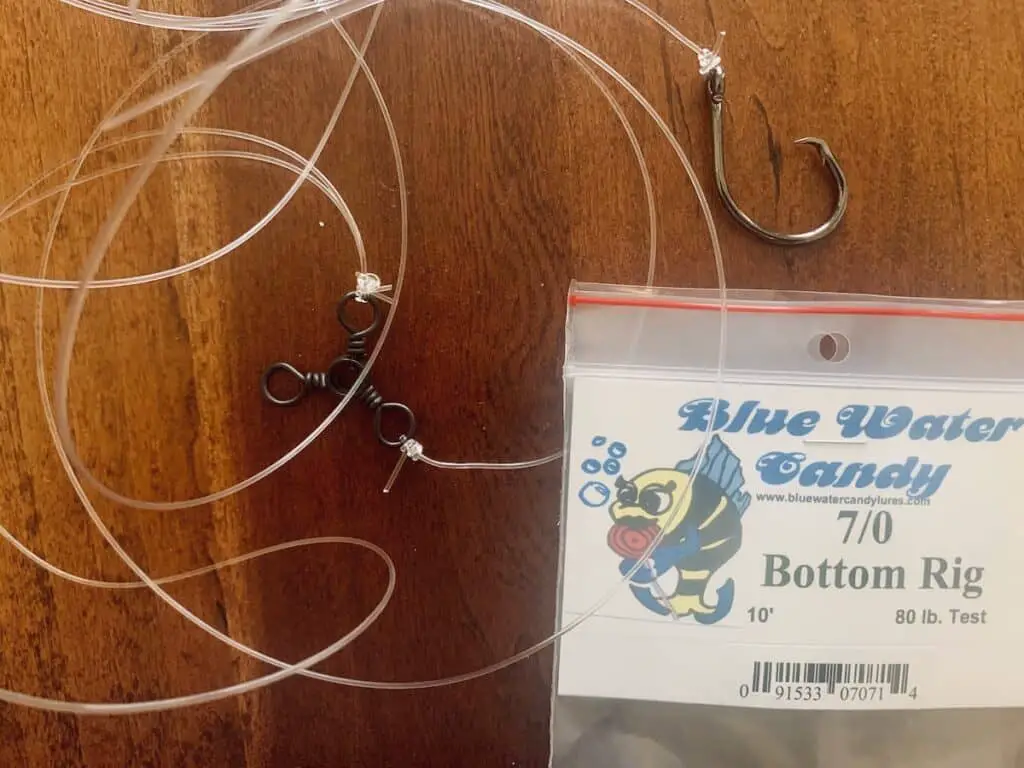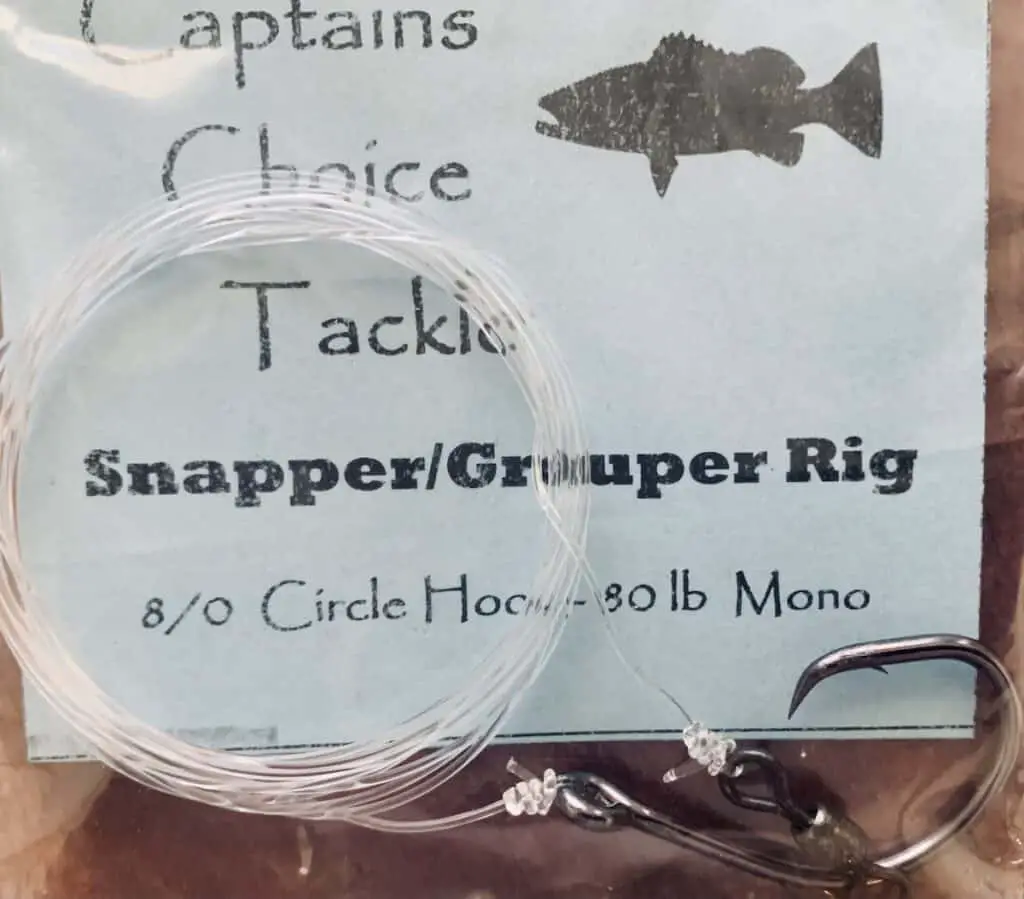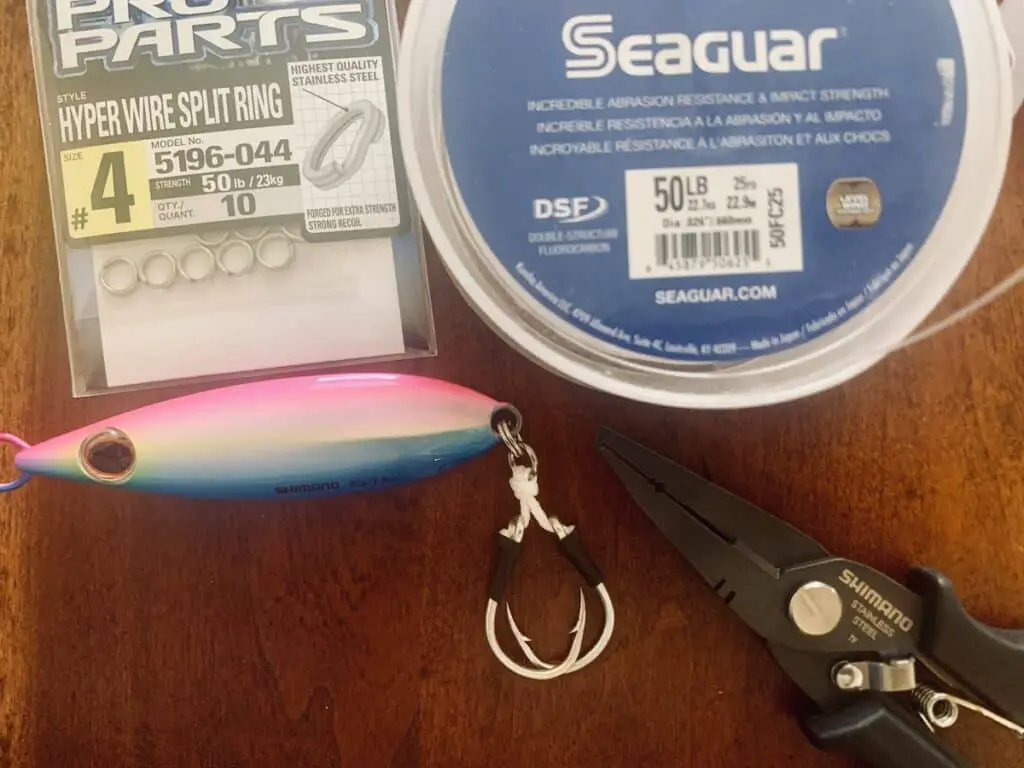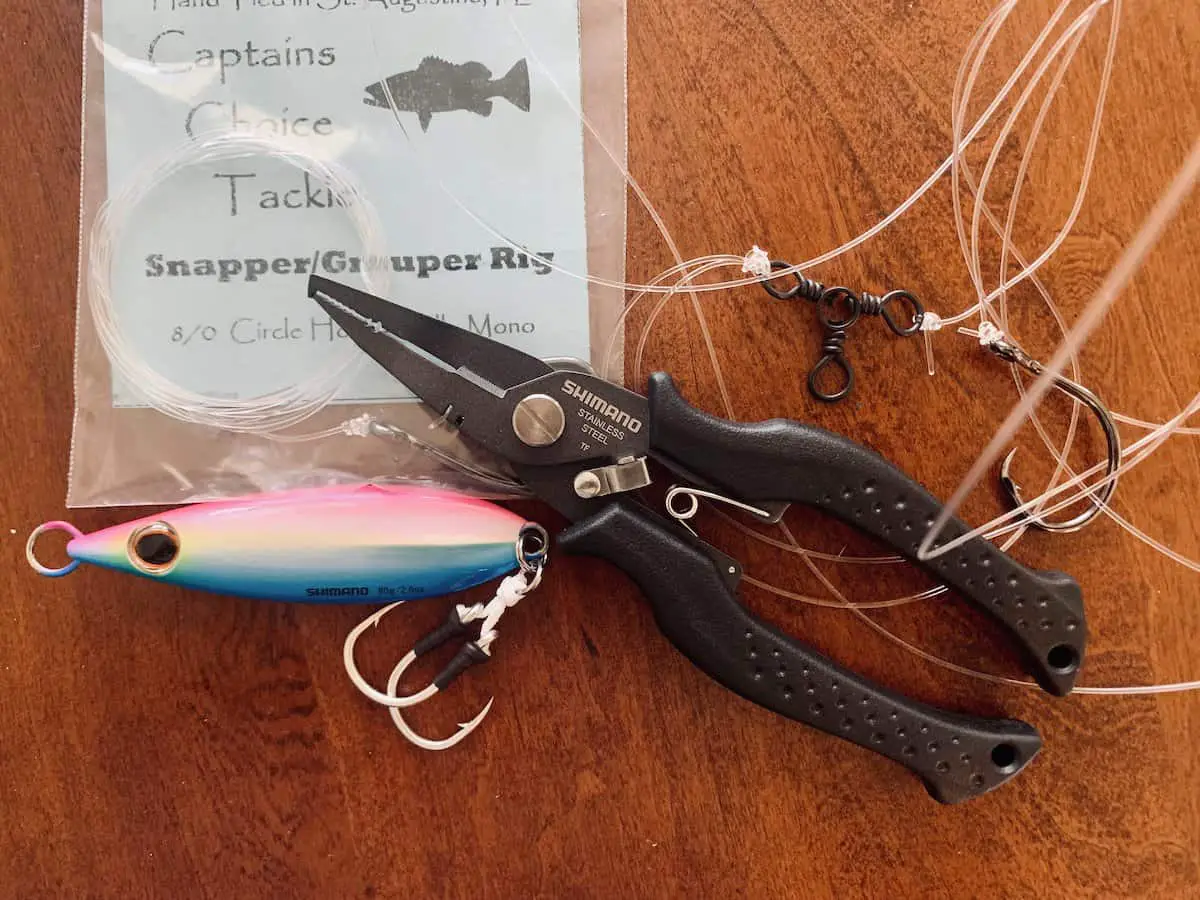Bottom fishing can be done with so many different rigs. If you’re just starting out, you may wonder what’s the best bottom fishing rig? The 3 Way Drop rig is best for live bait, the knocker rig is best for cut bait and rigging slow pitch jigs with assist hooks and split rings to a mono leader is best for slow pitch jigs. In the article below, you’ll find tips about why these are the best rigs to use, and the materials required to get set up.
My article Bottom Fishing: Everything You Need to Know tells you how to get started bottom fishing. Check it out!
Best Bottom Fishing Live Bait Rig: 3 Way Drop Rig
A 3 way drop rig is an effective rigging choice for bottom fishing with live bait. It consists of the main line tied to a 3 way swivel and 2 leaders tied to the other sides of the swivel. One of the leaders leads to a bank sinker and the other leads to a hook with live bait on it. The separation of the bait from the sinker gives the bait a natural look.
When rigging live bait for bottom fishing, you’ll want a rig that allows the bait to move naturally. The 3 way drop rig is a great option because the sinker will get the bait to the bottom, and the leaders keep the hooked bait a good distance from the sinker. This can also help improve the look of the bait, especially if you choose a fluorocarbon leader on the baited line.
A disadvantage that sometimes accompanies using live bait with 3 way drop rigs is the possibility of tangles. A swivel is between the leaders and the main line to help prevent line twist, but the fish can swim around the main line or the sinker line as its dropping and cause a tangled mess. You likely won’t catch anything if you’ve got a tangled 3 way drop rig.
Tangles can be hard to avoid. Your best option is a slow and steady drop to the bottom, clear of all the other lines on the boat. If you feel a tangle, reel it in, untangle it and try again.
Another potential disadvantage could be several knots leading to several potential failure areas. There are 5 knots in the setup, one between the main line and swivel, 2 between the leaders and swivel, and one to the hook and one to the sinker. When using this rig, make sure you tie good knots!

To tie a 3 way drop rig, you’ll need the following materials:
- 3 Way Swivel-this is really the centerpiece of the rig. The swivel joins the 3 different sections of line: main line, bait leader and sinker leader.
- Mono Leader-I recommend using monofilament as the leader line on the leg that connects to the bank sinker. You’ll get good abrasion resistance, low cost, and the thicker diameter doesn’t matter much since it won’t be attached to the bait. I trust the Triple Fish Monofilament Leader Line.
- Bank Sinker-A bank sinker can be used on this rig since the sinker doesn’t need to move up and down the line. It’ll be attached to the mono leader with a clinch knot. A bank sinker has a shape that’s designed to avoid getting stuck on structure like a reef.
- Fluorocarbon leader-I recommend using a fluorocarbon leader, like this Seaguar Blue Label Fluoro, on the leg that connects to the hook and bait. You’ve gone through some effort getting a hold of some live bait, and the last thing you want to do is give the fish a reason to be spooked off. Fluorocarbon is invisible in the water and makes for a great leader choice to live bait.
- Hook-If its legal for you to do so, you can opt to use a J hook here. For me, I’m in Florida and am required to use a circle hook, non-offset and non-stainless steel when targeting grouper, snapper, hogfish, and tilefish. I always like VMC inline black nickel circle hooks. You can hook your bait in a variety of ways, and my go to is usually up through the lips, closing its mouth.
Some anglers favor a hi low rig over a 3 way drop rig. A hi low rig is essentially a bigger 3 way drop rig that has an additional leader and bait on it. It can be a great way to target fish right on the bottom and those that are suspended a little above it too.
Now that you have the rig, you’ll need some live bait. Head over to my article Best Bottom Fishing Baits to learn which ones are best and how to find them.
Best Bottom Fishing Cut Bait Rig: Knocker Rig
A knocker rig is one of the simplest rigs you can use for bottom fishing. It consists of a hook tied to a leader line with an egg sinker sliding freely along the leader. The leader is joined to the main line with a swivel. Sometimes people will add a red bead in between the hook and the knocker to give it some color. The knocker rig is named the knocker rig because of how the sinker “knocks” into the hook eye.
One of the challenging things about bottom fishing offshore reefs and structure is the possibly of tangles. Usually there are several fishermen on the boat dropping their bottom lines off the same side of the boat. It can be easy to tangle lines with each other, and certain rigs can make matters worse. The knocker rig keeps the bait close to the sinker which helps minimize the chances of your rig tangling on itself or with other lines. This advantage is one of the main reasons I like to use it.
When fishing a nearshore reef in less than 100 yards of depth, I’ll usually start with a 1 oz sinker and see if it’s enough to reach bottom. The current strength and water depth both need to be considered when choosing a sinker size, so you’ll end up having to take a first guess and pack a variety of sinker sizes to swap to if needed.
Knocker rigs are usually used with cut bait. Live bait would be difficult to use with this rig since the hook is so close to the sinker most of the time. You could let more line out after the sinker hits the bottom, but it still wouldn’t let the live bait give much of a natural presentation. There is one exception, and that’s live shrimp. If you tail hook live shrimp on a knocker rig, it’ll keep your shrimp on the bottom and let it move naturally.

To tie a knocker rig, you’ll need the following materials:
- Barrel swivel-this will prevent any line twist from messing up your main line. The main line is tied to the barrel swivel with a clinch knot and the leader line is tied to the swivel with a clinch knot.
- Leader line-for offshore bottom fishing, I’d recommend between a 20 and 80 lb mono leader. Mono will give you the abrasion resistance you need around a reef. You can go lighter in line strength to minimize how visible the line is. As far as length, anywhere between 1 and 6 feet is good. I use longer length when around a larger reef or structure.
- Crimp sleeves (optional)-when targeting large grouper or snapper and using high pound test leader line strength, like 150 lbs, the connection between the swivel and leader, and the connection between the leader and hook is improved with the use of crimp sleeves. When using crimp connections, I usually go with a double barrel crimp sleeve so the tag and and the other end of the line have their own “channel”. I also recommend clipping the tag end neatly to avoid it snagging on anything.
- Hook-circle hook or J hook. Depending on the regulations in your area, you may be required to use a non-stainless steel, non-offset circle hook when using natural bait to target reef species. An example hook would be the VMC black nickel inline circle hook. When targeting grouper and snapper, a 7/0 size is a good starting point. The leader is tied to the hook with a clinch or snell knot. I have an in-depth article which discusses how to choose the best hook for bottom fishing, here.
- Egg sinker-You’ll thread the leader line through the egg sinker and the sinker will help the rig reach and stay on the bottom. The size depends heavily on the water depth and the current. I recommend bringing a variety of weights from 1 oz to 4 oz and use the lightest one that gets you to the bottom and stays put.
- Bead (optional)-If the fish aren’t biting, you can try a few different things. Adding a red bead between the hook and the egg sinker is a good way to add some color to attract fish. You’ll sometimes see two beads, one on either side of the sinker. You can also try decreasing the leader line strength to see if that’ll get them biting. A red bead is usually my go to, but feel free to try whatever color you want.
Knocker rigs can be purchased pre-made and are sometimes called “snapper rigs” or “grouper rigs”. The Buccaneer Snapper Pro Rig and the Buccaneer Grouper Pro Rigs are available at Tackle Direct. I recommend being cautious with pre-made rigs, especially if your local area has strict gear rules for reef fish. I live in Florida and usually can’t find rigs that have the non-stainless steel, non-offset circle hooks I need to use with cut bait.
How to Rig Slow Pitch Jigs
Slow pitch jigs are great artificial lures for bottom fishing. They work unlike any other artificial lure. Instead of sinking fast and straight down to the bottom, slow pitch jigs will turn horizontal in the water and wobble as they slowly fall to the bottom. The unique action of these lures imitates a dying baitfish.
When slow pitch jigging, your main line is likely braid and your leader line will be monofilament when fishing the offshore or nearshore reefs. Monofilament will provide the strongest abrasion resistance around the rough structure.
The jigs on these are typically rigged with heavy wire to prevent hooks breaking off when a toothy fish strikes. The hook dangles down the body of the jig and sets in the fish on the strike. When multiple hooks are used, some will hit in the mouth of the fish and some will hook external parts of the fish to get secure a solid grip.
I recommend not tipping these lures with bait, it’s unnecessary. If you do, be aware of the hook regulations—you may have to swap out the J hooks that come standard on a lot of them.
To rig a slow pitch jig, here are the materials you’ll need:
- Leader line: I recommend choosing monofilament when jigging around reefs and other structure. The abrasion resistance is critical in these types of areas. A good length for the leader is between 15 and 30 ft. Most conmonly, you’ll see an FG knot joining the braid main line to the mono leader.
- Swivel (optional)-A swivel can be placed between the main line and the leader. A swivel adds tackle to your rig and is only recommended if the lure you’re using spiral or twists. I wouldn’t use a swivel if I were using a wobbling lure, but if its one like the Shimano Monarch that spirals down, I’d use one.
- Hooks-most slow pitch jigs come pre-rigged with at least one assist hook. An assist hook is a hook with heavy core to attach it to a solid ring. You can purchase spare assist hooks or make your own with hooks and spectra cord. When changing or adding hooks to your jig, the spectra cord should be long enough for the hook to reach the midpoint of the lure. The hook should not be wider than the jig. Some of my favorite assist hooks include Owner stinger hooks and OTI assist hooks with flash. Keep extra hooks ready in case of break off. Avoid a treble hook since you’ll be around structure and it can make you frustrated with snagging.
- Split ring-the split ring is used to connect the lure eyelet and the solid ring which has the spectra cord and hook attached. You’ll need split ring pliers to manipulate the split ring. I made the mistake of trying to rig up some jigs for red snapper season without split ring pliers and it took me ten times as long as it should have!
- Solid ring-the cord is connected with a knot to the solid ring. The leader line is also tied to the solid ring. Most spare assist hooks do not come with a solid ring attached.
You can rig it however you’d like. Some options I’ve seen are one to two hooks on the top eyelet, plus 1-2 hooks on the bottom eyelet. Extra hooks can improve your hookup ratio, as long as it doesn’t scare them off or cause excessive snagging on bottom. If you use hooks on top and bottom eyelet, make sure your cord length appropriately avoids them tangling with each other.

If you’re interested in building up your collection of bottom fishing lures, check out my article on Best Bottom Fishing Lures, here. Tight lines, y'all!
Recent Posts
Fat Cow Jig Strips: The Ultimate Bucktail Jig Upgrade for Surf Fishing
As discussed in my previous article, "Surf Fishing with Bucktail Jigs: Ultimate Guide for Beach Anglers," bucktail jigs are a staple in any surf angler's tackle box, offering a versatile way to catch...
In my previous article, "Surf Fishing with Bucktail Jigs: Ultimate Guide for Beach Anglers," I introduced you to the bucktail jig and discussed how versatile of a lure it is for catching a wide range...

